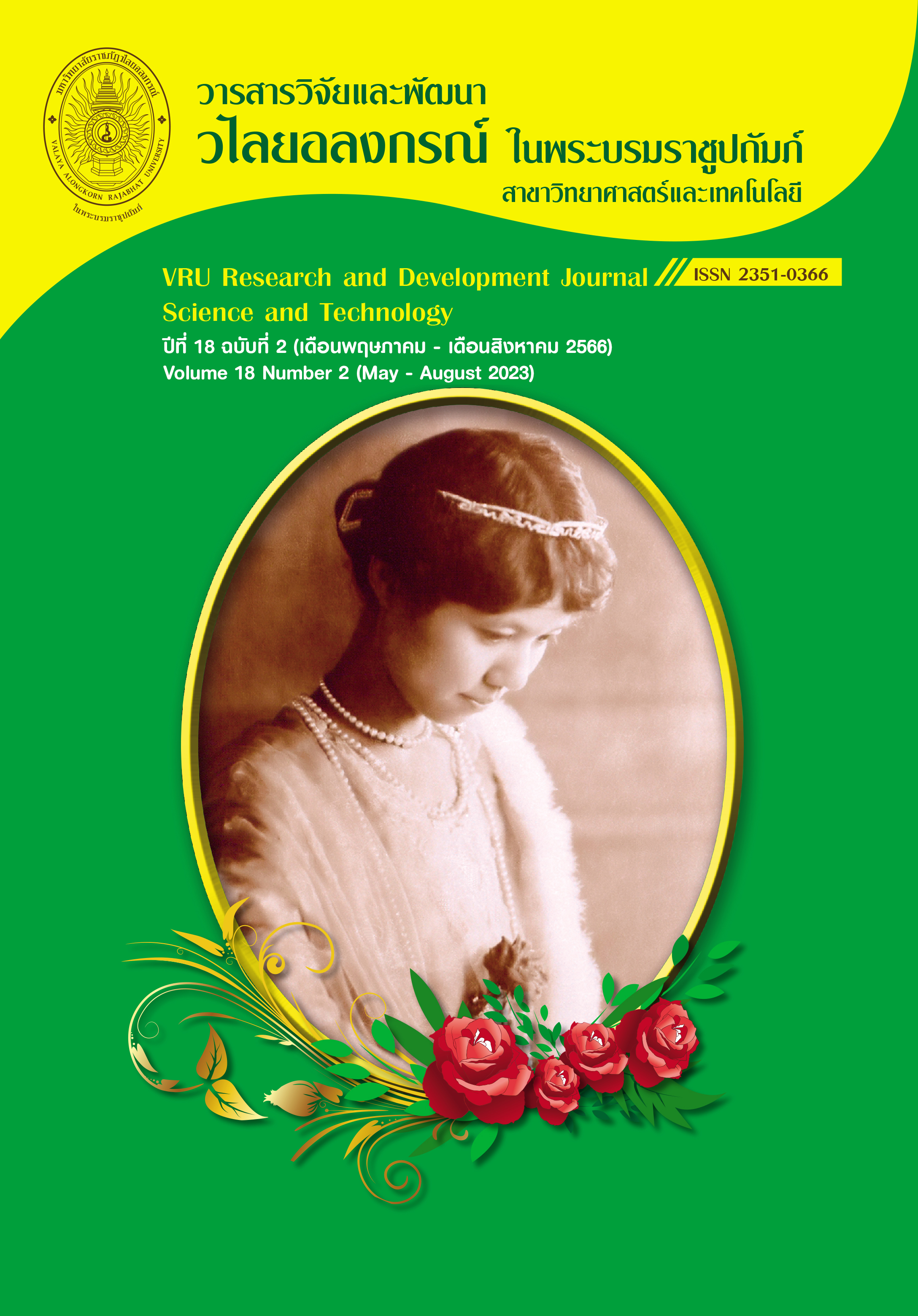EFFECTS OF CHEST X-RAY IMAGE SIZE ON MACHINE LEARNING PROCESSES AND THE EFFECTIVENESS OF CORONAVIRUS DISEASE 2019 PREDICTION MODELS
Main Article Content
Abstract
This research aimed to demonstrate how the differences in chest X-ray image sizes affect the execution time and efficiency of machine learning processes. The samples consisted of 299x299-pixel 15,153 chest X-ray images obtained from Kaggle.com. The experiment involved two approaches: reducing the image size to 20x20 and 30x30 pixels and increasing the image size to 800x800 and 1,024x1,024 pixels. The Random Forest algorithm was applied to build machine learning models for performance assessment. Two indicators, namely accuracy and execution time, were employed for the efficiency comparison. The findings revealed that the original 299x299 pixel chest X-ray images achieved an accuracy rate of 86.26% with an execution time of 9.17 minutes. For the X-ray images with the reduced sizes of 20x20 pixels and 30x30 pixels, the accuracy rates were 84.83% and 85.60%, and the execution times of 5.51 and 8.09 minutes. Conversely, enlarging the images to 800x800 and 1,024x1,024 pixels resulted in accuracy rates of 86.65% and 86.70%, with execution times of 28.56 and 31.06 minutes, respectively. This study proved that the execution time of machine learning processes and the effectiveness of image classification varied according to the size of chest X-ray images.
Downloads
Article Details
Copyright Notice
The copyright of research articles published in the VRU Research and Development Journal Science and Technology Journal belongs to the Research and Development Institute, Valaya Alongkorn Rajabhat University under the Royal Patronage. Reproduction of the content, in whole or in part, is prohibited without prior written permission from the university.
Responsibility
The content published in the VRU Research and Development Journal Science and Technology Journal is the sole responsibility of the author(s). The journal does not assume responsibility for errors arising from the printing process.
References
Alghamdi, H. S., Amoudi, G., Elhag, S., Saeedi, K., & Nasser, J. (2021). Deep learning approaches for detecting COVID-19 from chest X-ray images: A survey. IEEE Access, 9, 20235-20254.
Al Imran, A., Amin, M. N., & Johora, F. T. (2018). Classification of chronic kidney disease using logistic regression, feedforward neural network and wide & deep learning. Paper presented at the 2018 International Conference on Innovation in Engineering and Technology (ICIET).
Ausawalaithong, W., Thirach, A., Marukatat, S., & Wilaiprasitporn, T. (2018). Automatic Lung Cancer Prediction from Chest X-ray Images Using the Deep Learning Approach. Paper presented at the 2018 11th Biomedical Engineering International Conference (BMEiCON).
Chakraborty, S., Paul, S., & Hasan, K. A. (2022). A transfer learning-based approach with deep cnn for covid-19-and pneumonia-affected chest x-ray image classification. SN Computer Science, 3, 1-10.
Chowdhury, M. E., Rahman, T., Khandakar, A., Mazhar, R., Kadir, M. A., Mahbub, Z. B., . . . Al Emadi, N. (2020). Can AI help in screening viral and COVID-19 pneumonia? IEEE Access, 8, 132665-132676.
Itoo, F., Meenakshi, & Singh, S. (2021). Comparison and analysis of logistic regression, Naïve Bayes and KNN machine learning algorithms for credit card fraud detection. International Journal of Information Technology, 13(4), 1503-1511.
Khatami, A., Araghi, S., and Babaei, T. (2019). Evaluating the performance of different classification methods on medical X-ray images. SN Applied Sciences, 1(10), 1-7.
Laal, M. (2013). Innovation process in medical imaging. Procedia-Social and Behavioral Sciences, 81, 60-64.
Masadeh, M., Masadeh, A., Alshorman, O., Khasawneh, F. H., & Masadeh, M. A. (2022). An efficient machine learning-based COVID-19 identification utilizing chest X-ray images. IAES International Journal of Artificial Intelligence, 11(1), 356.
Oh, Y., Park, S., & Ye, J. C. (2020). Deep learning COVID-19 features on CXR using limited training data sets. IEEE transactions on medical imaging, 39(8), 2688-2700.
Rahman, T., Khandakar, A., Qiblawey, Y., Tahir, A., Kiranyaz, S., Kashem, S. B. A., . . . Khan, M. S. (2021). Exploring the effect of image enhancement techniques on COVID-19 detection using chest X-ray images. Computers in biology and medicine, 132, 104319.
Rahman, T., Chowdhur, M., and Khandakar, A. (2022). COVID-19 Radiography Database. Retrieved from https://www.kaggle.com/datasets/tawsifurrahman/covid19-radiography-database
Reshan, M. S. A., Gill, K. S., Anand, V., Gupta, S., Alshahrani, H., Sulaiman, A., & Shaikh, A. (2023). Detection of Pneumonia from Chest X-ray Images Utilizing MobileNet Model. Healthcare, 11(11), 1561.
Roy, S., Menapace, W., Oei, S., Luijten, B., Fini, E., Saltori, C., . . . Sentelli, A. (2020). Deep learning for classification and localization of COVID-19 markers in point-of-care lung ultrasound. IEEE transactions on medical imaging, 39(8), 2676-2687.
Salahuddin, Z., Woodruff, H. C., Chatterjee, A., & Lambin, P. (2022). Transparency of deep neural networks for medical image analysis: A review of interpretability methods. Computers in biology and medicine, 140, 105111.
Thambawita, V., Strümke, I., Hicks, S. A., Halvorsen, P., Parasa, S., & Riegler, M. A. (2021). Impact of image resolution on deep learning performance in endoscopy image classification: An experimental study using a large dataset of endoscopic images. Diagnostics, 11(12), 2183.
Veena, H., Sreeja, A. N., Reddy, K. H., Hasmitha, V., & Lavanya, R. (2022). Multiclass Deep Model for Diagnosis of COVID-19 using Chest X-ray. Paper presented at the 2022 6th International Conference on Trends in Electronics and Informatics (ICOEI).
Wang, L., Lin, Z. Q., & Wong, A. (2020). Covid-net: A tailored deep convolutional neural network design for detection of covid-19 cases from chest x-ray images. Scientific reports, 10(1), 1-12.
Wang, S., Zha, Y., Li, W., Wu, Q., Li, X., Niu, M., . . . Yu, H. (2020). A fully automatic deep learning system for COVID-19 diagnostic and prognostic analysis. European Respiratory Journal, 56(2).
Waranusast, R., & Pattanathaburt, P. (2022). The Development of Mobile Application for Assisting COVID-19 Antigen Test Kit Results Reading. Paper presented at the 2022 Asia-Pacific Signal and Information Processing Association Annual Summit and Conference (APSIPA ASC).
Wollek, A., Hyska, S., Sabel, B., Ingrisch, M., & Lasser, T. (2023). Exploring the Impact of Image Resolution on Chest X-ray Classification Performance. arXiv preprint arXiv:2306.06051.
Yadav, S. S., & Jadhav, S. M. (2019). Deep convolutional neural network based medical image classification for disease diagnosis. Journal of Big data, 6(1), 1-18.


